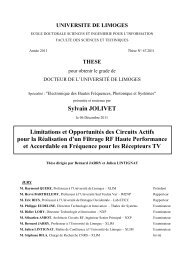Rôle de l'herpèsvirus humain de type 6 dans le ... - Epublications
Rôle de l'herpèsvirus humain de type 6 dans le ... - Epublications
Rôle de l'herpèsvirus humain de type 6 dans le ... - Epublications
Create successful ePaper yourself
Turn your PDF publications into a flip-book with our unique Google optimized e-Paper software.
<strong>Rô<strong>le</strong></strong> <strong>de</strong> l’herpèsvirus <strong>humain</strong> <strong>de</strong> <strong>type</strong> 6 (HHV-6)<br />
<strong>dans</strong> <strong>le</strong> syndrome d’hypersensibilté médicamenteuse et <strong>le</strong> lymphome <strong>de</strong> Hodgkin<br />
Résumé<br />
L’herpèsvirus <strong>humain</strong> <strong>de</strong> <strong>type</strong> 6 (HHV-6) est un virus lymphotrope, présentant <strong>de</strong>ux variants A et<br />
B. Le variant B est associé au syndrome d’hypersensibilité médicamenteuse ou DRESS (drug rash with<br />
eosinophilia and systemic symptoms), et est éga<strong>le</strong>ment étudié pour son implication <strong>dans</strong> <strong>le</strong> lymphome <strong>de</strong><br />
Hodgkin (LH).<br />
Le DRESS est une maladie rare, qui apparaît en réponse à une prise médicamenteuse, se<br />
manifestant par une fièvre é<strong>le</strong>vée, une éosinophilie et une éruption cutanée importante et qui peut<br />
s’accompagner d’une atteinte viscéra<strong>le</strong>. La réplication in vitro <strong>de</strong> l’HHV-6 a été quantifiée en présence <strong>de</strong><br />
molécu<strong>le</strong>s causa<strong>le</strong>s du DRESS. Une stimulation <strong>de</strong> la réplication vira<strong>le</strong> en présence <strong>de</strong> valproate <strong>de</strong><br />
sodium, carbamazépine et amoxicilline a été mise en évi<strong>de</strong>nce, suggérant que la réactivation <strong>de</strong> l’HHV-6<br />
est un événement précoce <strong>dans</strong> <strong>le</strong> dérou<strong>le</strong>ment du DRESS. De plus, l’étu<strong>de</strong> <strong>de</strong>s données virologiques <strong>de</strong><br />
patients atteints <strong>de</strong> DRESS a permis <strong>de</strong> confirmer que la réactivation <strong>de</strong> l’HHV-6 est un phénomène<br />
fréquent <strong>dans</strong> cette maladie.<br />
Afin <strong>de</strong> préciser <strong>le</strong> rô<strong>le</strong> <strong>de</strong> l’HHV-6 <strong>dans</strong> <strong>le</strong> LH, l’action <strong>de</strong> l’oncoprotéine vira<strong>le</strong> DR7 sur <strong>le</strong><br />
comportement cellulaire a été étudiée. Des dérégulations similaires à cel<strong>le</strong>s décrites <strong>dans</strong> <strong>le</strong>s cellu<strong>le</strong>s <strong>de</strong><br />
Reed-Sternberg, caractéristiques du LH, ont été observées <strong>dans</strong> <strong>de</strong>s cellu<strong>le</strong>s B surexprimant DR7. Ces<br />
dérégulations aboutissent à une prolifération et une résistance à la mort cellulaire accrue, ainsi qu’à une<br />
modulation <strong>de</strong> l’expression <strong>de</strong> marqueurs spécifiques.<br />
Ces travaux ont permis <strong>de</strong> montrer que la réactivation <strong>de</strong> l’HHV-6 est un événement précoce et<br />
causal <strong>dans</strong> <strong>le</strong> DRESS, et d’argumenter en faveur d’un rô<strong>le</strong> pathogénique <strong>de</strong> l’HHV-6 <strong>dans</strong> la<br />
lymphomagenèse du LH.<br />
Mots-clés : HHV-6, syndrome d’hypersensibilité médicamenteuse, lymphome <strong>de</strong> Hodgkin, DR7, cellu<strong>le</strong> <strong>de</strong><br />
Reed-Sternberg<br />
Ro<strong>le</strong> of human herpesvirus 6 (HHV-6)<br />
in drug hypersensibility syndrome and Hodgkin’s lymphoma<br />
Abstract<br />
Human herpesvirus 6 (HHV-6) is a lymphotropic virus which exists as two variants named A and<br />
B. B variant is associated with drug hypersensitivity syndrome or DRESS (drug rash with eosinophilia<br />
and systemic symptoms), and is studied for its implication in Hodgkin’s lymphoma (HL).<br />
DRESS is a rare, drug-induced reaction, characterized by high fever, eosinophilia, cutaneous<br />
eruption and potential visceral involvement. HHV-6 replication in vitro was quantified in presence of<br />
drugs responsib<strong>le</strong> for DRESS. A stimulation of viral replication by sodium valproate, carbamazepine<br />
and amoxicillin was shown, suggesting that HHV-6 reactivation is an early event in the time course of<br />
DRESS. Moreover, virological data from DRESS patients allow us to observe that HHV-6 reactivation<br />
is a frequent event in DRESS.<br />
The ro<strong>le</strong> of HHV-6 in HL was studied through viral oncoprotein DR7 action on cellular functions.<br />
B cells overexpressing DR7 exhibited <strong>de</strong>regulations similar to those reported for Reed-Sternberg cells,<br />
which are characteristic cells of HL. Increased proliferation and cell <strong>de</strong>ath resistance, and modulation<br />
of specific markers were observed.<br />
This work showed that HHV-6 reactivation is an early and causative event in DRESS, and results<br />
concerning DR7 argue in favour of a pathogenic ro<strong>le</strong> of HHV-6 in HL.<br />
Keywords : HHV-6, drug hypersensitivity syndrome, Hodgkin’s lymphoma, DR7, Reed-Sternberg cell<br />
183

















